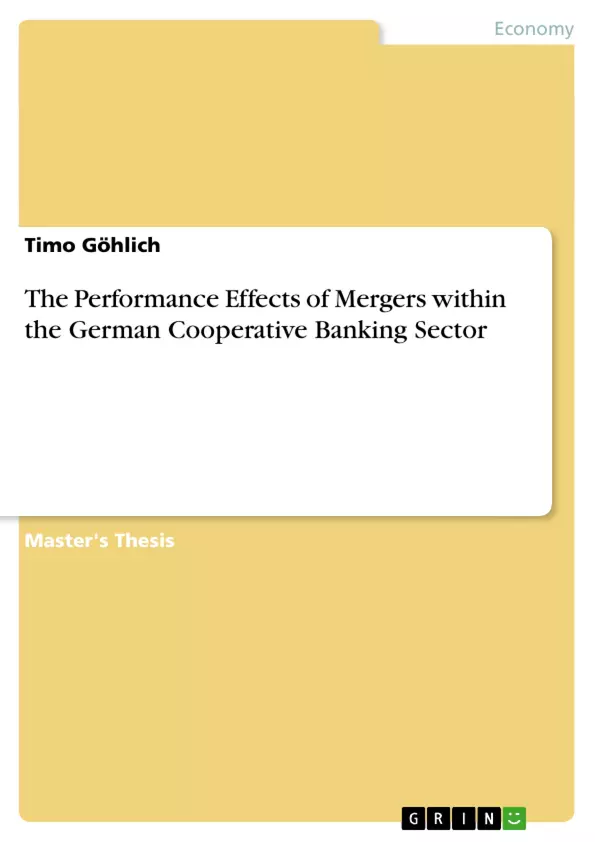Blick ins Buch

The Performance Effects of Mergers within the German Cooperative Banking Sector
Masterarbeit, 2012
92 Seiten, Note: 8
Leseprobe
Inhaltsverzeichnis (Table of Contents)
- Introduction
- Literature Review
- Theory of M&A Performance Changes and Strategic Similarities
- The Agency Theory
- The Synergy Theory
- The Market Power Theory
- The Concept of Strategic Similarities
- Summary of the Theoretical Concepts
- Empirical Evidence
- The Agency Theory: Empirical Evidence
- The Synergy Theory: Empirical Evidence
- The Market Power Theory: Empirical Evidence
- The Concept of Strategic Similarities: Empirical Evidence
- Summary of the Empirical Evidence
- The German Cooperative Banking Sector
- Summary
- Theory of M&A Performance Changes and Strategic Similarities
- Hypotheses
- Hypotheses Development
- Summary
- Methodology and Data
- Methodology
- Data
- Summary
- Empirical Results
- Empirical Results (H1 - H3)
- Empirical Results (H4)
- Summary
- Remarks
Zielsetzung und Themenschwerpunkte (Objectives and Key Themes)
This thesis examines the performance effects of mergers within the German Cooperative Banking Sector. It aims to analyze how mergers impact financial performance, taking into account the specific dynamics of this sector. The key themes explored in the thesis include:- Theories of merger performance changes, such as agency theory, synergy theory, and market power theory.
- The concept of strategic similarities and its relevance to merger success.
- Empirical evidence on merger performance in various contexts, including the German Cooperative Banking Sector.
- The development and testing of hypotheses regarding merger effects on financial performance.
- A detailed analysis of the German Cooperative Banking Sector and its specific characteristics.
Zusammenfassung der Kapitel (Chapter Summaries)
The introduction lays the foundation for the study, presenting the research problem and its significance. It also outlines the structure of the thesis and provides a brief overview of the key themes. The literature review section delves into the existing theoretical and empirical research on merger performance. This section examines various theories, including agency theory, synergy theory, and market power theory, and explores their implications for merger outcomes. It also presents a detailed analysis of empirical evidence from previous studies, focusing on the factors that influence merger success or failure. The section on the German Cooperative Banking Sector provides a comprehensive overview of its structure, key characteristics, and recent developments. It also highlights the specific challenges and opportunities faced by banks in this sector, setting the stage for the analysis of merger effects.Schlüsselwörter (Keywords)
The main keywords of the thesis are: mergers and acquisitions, financial performance, cooperative banking sector, agency theory, synergy theory, market power theory, strategic similarities, empirical evidence, German banking system, and financial performance analysis. This research focuses on the impact of mergers on the financial performance of German cooperative banks, drawing on existing theories and conducting empirical analysis.
Ende der Leseprobe aus 92 Seiten
- nach oben
Details
- Titel
- The Performance Effects of Mergers within the German Cooperative Banking Sector
- Hochschule
- University of Twente (School of Management and Governance)
- Note
- 8
- Autor
- Timo Göhlich (Autor:in)
- Erscheinungsjahr
- 2012
- Seiten
- 92
- Katalognummer
- V204026
- ISBN (eBook)
- 9783656319788
- ISBN (Buch)
- 9783656321002
- Dateigröße
- 1308 KB
- Sprache
- Englisch
- Anmerkungen
- In the following thesis I examine the performance effects of merger within the German cooperative banking sector on the basis of agency, synergy and market power related changes. Furthermore, from a strategic management perspective the role of strategic similarities is analyzed. Performance enhancing effects are found from...
- Schlagworte
- Genossenschaft Bank Volksbank Fusion Merger M&A empirisch quantitativ
- Produktsicherheit
- GRIN Publishing GmbH
- Preis (Ebook)
- US$ 38,99
- Preis (Book)
- US$ 50,99
- Arbeit zitieren
- Timo Göhlich (Autor:in), 2012, The Performance Effects of Mergers within the German Cooperative Banking Sector, München, Page::Imprint:: GRINVerlagOHG, https://www.diplomarbeiten24.de/document/204026
Allgemein
Autoren
- Autor werden
- Ihre Optionen
- Vertriebskanäle
- Premium Services
- Autorenprofil
- Textarten und Formate
- Services für Verlage, Hochschulen, Unternehmen
Premium Services
FAQ
Marketing
Dissertationen
Leser & Käufer
Zahlungsmethoden

Copyright
- © GRIN Publishing GmbH.
- Alle Inhalte urheberrechtlich geschützt. Kopieren und verbreiten untersagt.
- info@grin.com
- AGB
- Open Publishing
Über GRIN
Der GRIN Verlag hat sich seit 1998 auf die Veröffentlichung akademischer eBooks und Bücher spezialisiert. Der GRIN Verlag steht damit als erstes Unternehmen für User Generated Quality Content. Die Verlagsseiten GRIN.com, Hausarbeiten.de und Diplomarbeiten24 bieten für Hochschullehrer, Absolventen und Studenten die ideale Plattform, wissenschaftliche Texte wie Hausarbeiten, Referate, Bachelorarbeiten, Masterarbeiten, Diplomarbeiten, Dissertationen und wissenschaftliche Aufsätze einem breiten Publikum zu präsentieren.
Kostenfreie Veröffentlichung: Hausarbeit, Bachelorarbeit, Diplomarbeit, Dissertation, Masterarbeit, Interpretation oder Referat jetzt veröffentlichen!
- GRIN Verlag GmbH
-
- Nymphenburger Str. 86
- 80636
- Munich, Deutschland
- +49 89-550559-0
- +49 89-550559-10
- info@grin.com
-









